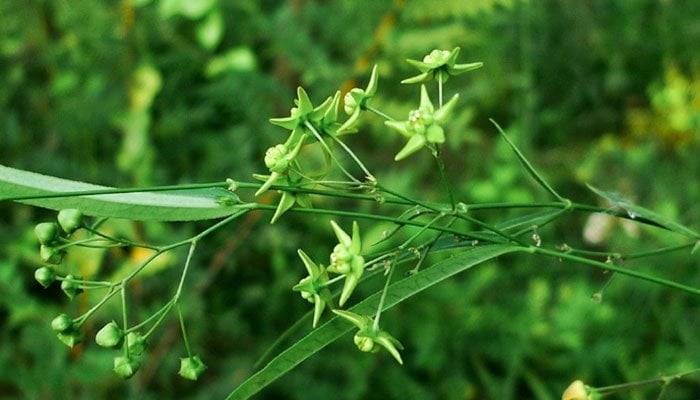What Is Xu Chang Qing
Xu Chang Qing also known as Radix et Rhizoma Cynanchi Paniculati is the root and rhizome of Cynanchum paniculatum, which is a perennial herb belonging to the family Asclepiadaceae. It is a relatively practical and common Chinese herbal medicine, which first appeared in <Shennong Ben Cao Jing> in the late Western Han Dynasty (around 100 BCE).
Cynanchum paniculatum is highly adaptable and likes a warm and humid environment. They grow well in rich, deep, well-drained sandy loam. They often grow on sunny hillsides and grasses. Because of their high medicinal value, they have been widely cultivated in most of China. They are distributed in China, Mongolia, Korea, and Japan.
In autumn, people gather the roots and rhizomes of Cynanchum paniculatum, remove impurities, quickly wash them with water, cut them into sections, dry them in the shade, and make them into Chinese herbal medicine.

Xu Chang Qing contains paeonol, acetophenone, 3-methoxyacetophenone, 2-hydroxy-5-methoxyacetophenone, acetovanillone, hexadecane, eicosane, methyl salicylate, p-hydroxyacetophenone, 3-hydroxyacetophenone, 3-methylphenol, syringaldehyde, benzoic acid, p-methoxybenzoic acid, cinnamic acid, apocynin, α-guaiene, α-bulnesene, β-ionone, transphytol, bornyl acetate, eugenol, 2-pentyl-furan, caryophyllene oxide, β-damascenone, 4-acetylphenol, β-caryophyllene, β-ionone, caryophylleneoxide, menthone, stearic acid, palmitic acid, oleic acid, linoleic acid, myristcin, dibutyl phthalate, cynanversicoside D, cynanversicoside E, cynanoside K, cynanoside J, cynapanoside A-G, glaucoside A, glaucogenin A-D, neocynapanogenin, corumbelloside II, sterols, polysaccharides, flavonoids, lignins, alkaloids, and phenols.
Generally, yellowish-white to brown Xu Chang Qing with a yellowish-white cross-section, a fine wood heart, and a strong aroma is preferred.
According to <Compendium of Materia Medica>, the medicinal nature of Xu Chang Qing is relatively warm, with a pungent taste. It has a certain therapeutic effect on the pathological changes of the liver and stomach meridians.
In traditional Chinese medicine, it is often used to expel wind and dampness, relieve pain and itching, and treat rheumatic arthritis, rheumatoid arthritis, sciatica, costal neuralgia, urinary calculi, toothache, low back pain, stomach pain, dysmenorrhea, rubella, eczema, urticaria, ringworm, snake bite, and traumatic injury.
There are about 100 kinds of traditional Chinese medicine prescriptions containing it, such as Yangzheng Xiaoji Capsules, Xue Zhi Ping Capsules, and Yun Xiang Qu Feng Zhi Tong Ting.
Benefits
- Anti-inflammation, inhibiting xylene-induced mouse ear swelling and sterile cotton ball-induced mouse granulation tissue growth.
- Increasing pain threshold and reducing the number of writhing in mice induced by acetic acid.
- Increasing coronary blood flow, relieving myocardial cell damage, improving myocardial diastolic ability, enhancing myocardial contraction, and preventing myocardial dysfunction.
- Reducing platelet aggregation, preventing atherosclerosis and thrombosis.
- Expelling wind and dampness, treating wind-cold-damp arthralgia, joint pain, muscular spasms, soreness and weakness of waist and knees.
- Relieve stomach pain, toothache, dysmenorrhea, and bruising.
- Treating itching caused by rubella and eczema.
- Paeonol can inhibit the proliferation of hepatoma cells HepG2 and SMMC-7721 and induce their apoptosis.
- Its decoction has a significant inhibitory effect on ovalbumin-induced passive skin allergic reactions in rats.
- Its polysaccharides can promote the proliferation of spleen cells and lymphocytes, enhance the function of T cells and B cell immune cells, and improve the body’s immunity.
- Its methanol extract can protect mice hippocampal HT22 cells against glutamate-induced neuronal cytotoxicity[1].
- Its ethanol extract can improve the survival rate of herpes simplex virus-infected mice, prevent nerve cell damage after herpes simplex virus infection, reduce brain cell death rate, and have a protective effect on herpes simplex virus encephalitis cell damage.
- The study found that its ethanol extract can inhibit the activity of the venom protease of Deinagkistrodon acutus and hyaluronidase, thereby weakening the lethality of the deinagkistrodon acutus venom to rats. It has an anti-venom effect.
Combinations
- It can be used in combination with Fang Ji (Radix Stephaniae Tetrandrae), Wei Ling Xian (Radix Clematidis), Mu Gua (Fructus Chaenomelis), etc. to treat wind-cold-damp arthralgia, joint pain, and muscular spasms.
- It can be used in combination with Du Zhong (Eucommia Bark), Xu Duan (Radix Dipsaci), Du Huo (Radix Angelicae Pubescentis), etc. to treat soreness and weakness of waist and knees caused by deficiency of the liver and kidney, or cold-dampness obstruction.
- It can be used in combination with Gao Liang Jiang (Rhizoma Alpiniae Officinarum), Yan Hu Suo (Rhizoma Corydalis), etc. to treat abdominal flatulence and stomach pain caused by qi stagnation due to congealing cold.
- It can be used in combination with Chuan Xiong (Rhizoma Chuanxiong), Dang Gui (Radix Angelicae Sinensis), Xiang Fu (Rhizoma Cyperi), etc. to treat irregular menstruation and dysmenorrhea.
- It can be used in combination with Bai Xian Pi (Cortex Dictamni), Ku Shen (Radix Sophorae Flavescentis), Huang Bai (Cortex Phellodendri), etc. to treat rubella and eczema.
Side Effects
- At present, there are no reports in the literature that Xu Chang Qing has toxic effects, and there are no reports of serious adverse reactions when it is taken according to the prescribed dose.
Precautions and Warnings
- The dosage of Xu Chang Qing should be controlled at 3-12g.
- It can be made into decoctions, pills, powders, or tinctures.
- It contains a lot of volatile oil and is not suitable for long decoction.
- When making prescriptions containing it, other medicines should be boiled first, and when the other medicines are almost ready, add Xu Chang Qing and decoct them slightly.
- People who are allergic to Xu Chang Qing should not take it.
- Frail patients should not take it.
- Pregnant and breastfeeding women should not take it.
